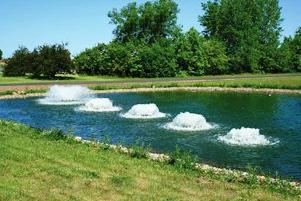If there is enough oxygen in a pond or other artificial pond , then the good quality of the water and the excellent health of its inhabitants are provided. The enrichment of water with oxygen occurs using a device called an “aerator”. For a pond of any size, this is the only means that can, without the use of chemicals, create favorable conditions for the existence of underwater and water flora and fauna. The use of these devices guarantees the required level of oxygen in the water, reduction of bottom sediments, and regulation of the rate of development of microalgae.
When choosing an aerator for a pond, determine the type of equipment required. The following types of these devices are distinguished:
- Surface aerators. They are the most widespread, a large number of models with different power and performance. A surface pond aerator sprays water above the surface. At the same time, falling water jets are enriched with oxygen from the air, effectively increasing its content. This type of aeration allows you to quickly increase the level of oxygen in a pond at low energy costs. Its only drawback is the increased noise from work.
- Injector aerators have a different principle of action: they suck in air, mixing it with a stream of water. Their efficiency is slightly lower (high energy costs), but the noise level is much less.
- A bottom aerator is a recent development by American scientists. At low energy costs, this pond aerator can not only increase the level of oxygen on the surface of the water, but also in its entire thickness. Due to the active mixing of water, stagnation is eliminated, the temperature of different layers is leveled, icing is prevented in the cold season.
Oxygen deficiency provokes not only fish diseases, but also significantly worsens biting. For organizations engaged in paid fishing, maintaining the oxygen level in the reservoir at a level of 90-100% guarantees a normal bite. Choosing an aerator for a pond, you need to focus primarily on the volume of the reservoir. The power of the required unit depends on this. For a more uniform oxygen saturation of large ponds over the area, it is advisable to use several devices that are placed evenly throughout the pond.

Aeration of the pond must be carried out all year round. In winter and summer, this will allow you to mix the layers of water, aligning their temperature. In the fall, this procedure will allow the pond to be cleaned efficiently, and then winter without loss. In winter, aeration relieves aquatic inhabitants of the harmful gases that accumulate under the ice. Spring enrichment of water with oxygen stimulates the development of bacteria that will improve the ecological balance of the pond.
It is clear that to ensure the normal growth of fish and microorganisms in a pond, an aerator is needed for the pond. The price primarily depends on the capacity of the unit. Sometimes it is big enough. It is not necessary to purchase ready-made devices: with minimal experience, you can make an aerator for the pond with your own hands.